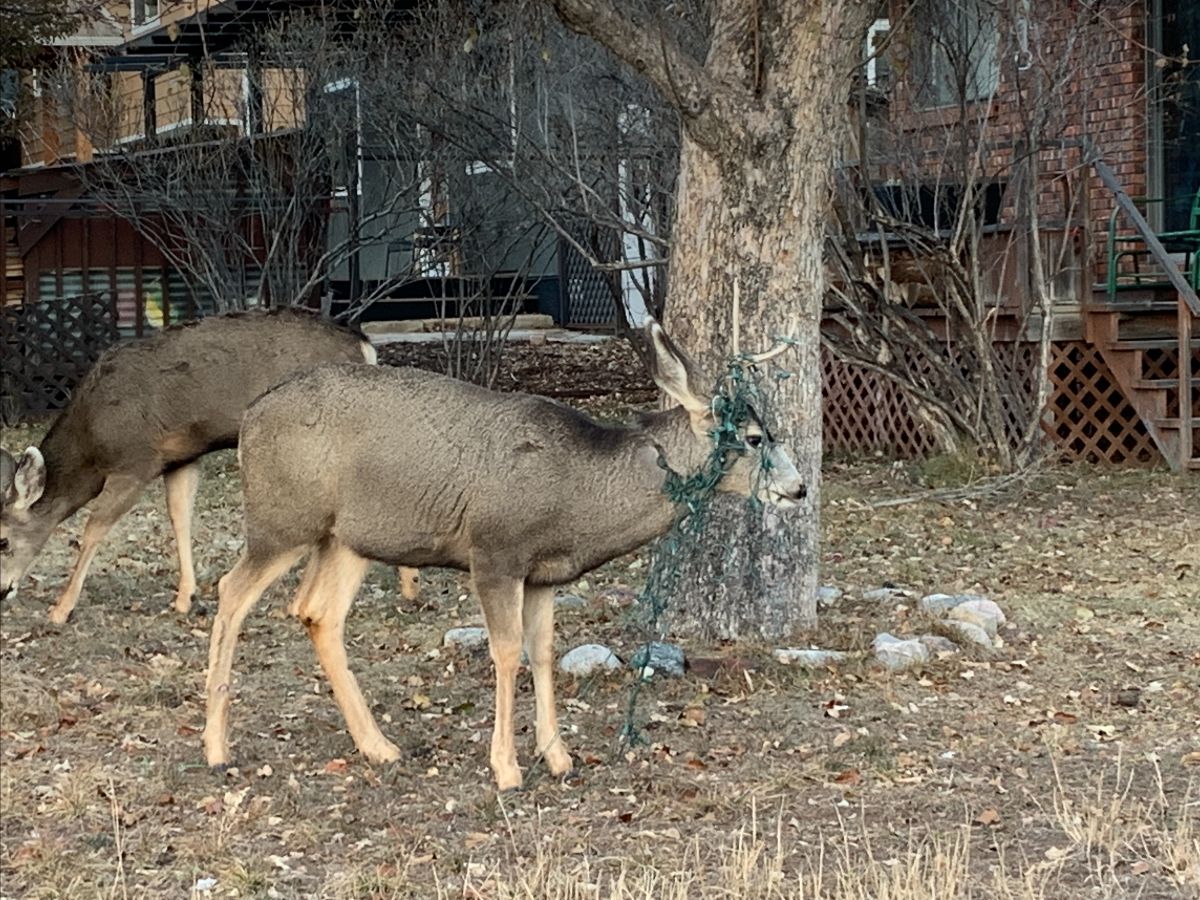Landowners Urged to Remove Potential Hazards for Antlered Wildlife
Below is a news release from Colorado Parks and Wildlife. Though the release focuses on Colorado, landowners nationwide are encouraged to remove potential entanglements from their property.
Halloween decorations can create a real scare when antlered wildlife get tangled up in them, and that’s only a small fraction of the human-created hazards deer, elk and moose can encounter in yards each fall. All of these hazards can be prevented by the public doing its part.
Colorado Parks and Wildlife asks Coloradans to assess their outdoor spaces and remove potential tangle hazards for antlered wildlife that are in migration from summer habitat to winter range while they seek mating opportunities.
CPW officers respond every year to incidents where antlered animals have become dangerously entangled. Common hazards include hammocks, holiday decorations, garden items such as tomato cages as well as soccer goals and netting from sports such as tennis and volleyball.
People can do their part to be a good neighbor to wildlife by putting away summer recreational and landscaping equipment that is not in use and to make sure holiday lights and decorations are secured tightly wherever they are hung.
“Right now is a good opportunity to clean up your yard and to remove items a curious animal might stick its nose in or get wrapped up in,” said CPW Assistant Area Wildlife Manager Steve McClung out of the Durango office. “And when you’re putting up decorations, keep wildlife in mind. We see animals get wrapped up all the time, and all of these impairments can affect their mobility, vision and ability to eat and drink.”
Bucks can be especially prone to these situations this time of year. During the rut – or breeding season – bucks will rub their antlers on objects to mark territory and signal their presence to other bucks. The rut has started for deer and will hit its peak in mid-November through December.
When animals such as deer and elk become entangled, the stress involved and the physical exhaustion caused by trying to break free can lead to death.
Wildlife officers can often get deer untangled if they are nearby and notified in a timely manner. In some cases, they will cut off the animal’s antlers to free it. In other instances, they can remove the object. Some cases do not require human assistance if the entanglement is not preventing the animal from eating or drinking or if there is low risk that the animal could get caught up in other items that would prevent it from being mobile. In those instances, the animal will be free of the burden when it sheds its antlers.
“We need to know about these situations quickly,” McClung said. “It’s best if we can get to these animals before they’ve undergone too much stress and have exhausted themselves. Darting them also creates stress and can lead to mortality if the animal has already been stressed too much.
“If the animal is not tethered to what it is tangled in, it can be difficult to chase them through a neighborhood and get into a position to dart them, or sometimes they disappear and we never catch up to help them. The sooner we get information, the more likely we will be able to assist that animal.”
CPW recommends holiday lights and decorations be placed higher than six feet or attached tightly to trees and buildings. Lights or webs that hang low or are draped insecurely over vegetation easily get tangled in antlers.
Because Halloween decorations have grown in popularity, CPW has responded to increased incidents of wildlife getting tangled in everything from fake spider webs and plastic skeletons to plastic pumpkins typically used for trick-or-treating.
“Deer are curious and want to check out something that’s hanging along their path or a bucket to see if it’s food,” McClung said. “They may stick their nose in and get those objects stuck around their face or get the handle caught on an antler.”
It has also become increasingly popular for people to bring holiday decorations onto public lands for social media photo opportunities. CPW reminds the public to pack out whatever they pack in and to never leave decorations out where they can present a danger to wildlife.
If you see wildlife that does become entangled, report it directly to CPW by calling the office local to you or through Colorado State Patrol if it is outside of normal business hours. When calling CSP, they will relay your information to the on-call wildlife officer in your area.
Be prepared when calling with information regarding the animal’s location and time observed, its behavior, whether it is tied to an object or still mobile and if the hazard is preventing the animal from eating, drinking or breathing.
Never try to free an animal from an entanglement yourself. A stressed animal may act more aggressively and their hooves and antlers can cause serious injury.
During the fall breeding season, it is important to give antlered wildlife more space and to use increased caution in their presence. During the rut, these animals have a one-track mind looking for a mate. They can become agitated if any other animal, object or person appears to be posing a challenge. Dogs are often targets and can be badly injured by a buck’s antlers.
Deer can become aggressive toward humans, too, so stay well away from them. Attacks get reported around the state each fall, and there has already been one attack this year in Aspen.
Deer regularly seen in neighborhoods may appear docile and not pay much attention to the presence of humans much of the year but may behave aggressively this time of year.
(Photo credit: John Livingston/Colorado Parks and Wildlife)
